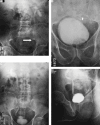Urogenital Tuberculosis
- PMID: 28087922
- PMCID: PMC11687435
- DOI: 10.1128/microbiolspec.TNMI7-0015-2016
Urogenital Tuberculosis
Abstract
Urogenital tuberculosis is the second most frequent form of extrapulmonary tuberculosis. Starting with a pulmonary focus, 2 to 20% of patients develop urogenital tuberculosis through hematogenous spread to the kidneys, prostate, and epididymis; through the descending collecting system to the ureters, bladder, and urethra; and through the ejaculatory ducts to the genital organs. Urogenital tuberculosis occurs at all age ranges, but it is predominant in males in their fourth and fifth decades. It is a serious, insidious disease, generally developing symptoms only at a late stage, which leads to a diagnostic delay with consequent urogenital organ destruction; there are reports of patients with renal failure as their initial clinical presentation. Although the condition has been long recognized by nephrologists, urologists, and infectious disease specialists, urogenital tuberculosis is still largely unknown. Even when suggestive findings such as hematuria, sterile pyuria, and recurrent urinary infections are present, we rarely remember this diagnostic possibility. Greater knowledge of the features of urogenital tuberculosis then becomes relevant and should emphasize the importance of an early diagnosis.
Figures





References
-
- Leite OHM. 2001. Tuberculosis. Probl Gen Surg 18:69–78.
-
- Gow JG. 1998. Genitourinary tuberculosis, p 807–836. In Walsh PC, Retik AB, Vaughan ED, Wein AJ (ed), Campbell’s Urology, 7th ed. WB Saunders Company, Philadelphia, PA.
Publication types
MeSH terms
Substances
LinkOut - more resources
Full Text Sources
Other Literature Sources
Medical

